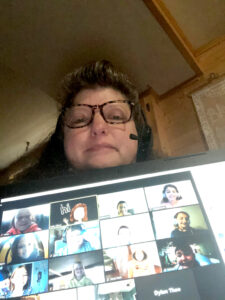By David Fleet
Editor
Goodrich- It’s lunchtime in Mrs. Kelly Alford’s third grade classroom.
From noon to 1 p.m. each school day, it’s sandwiches, juice boxes and the spirited chatter of about 30 active 8 and 9-year-old students dominates the  combined social hour, recess and lunch.
combined social hour, recess and lunch.
For almost three decades Alford interacted with students faced to face—recognizing a litany of nuances in a classroom of young adults.
Then came COVID-19, the face-to-face classroom went silent sparking a host of new challenges both educationally and emotionally.
“Due to the COVID, today virtual and face-to-face teaching is tough work,” said Alford. “It’s like building a plane while you’re flying it. I feel like a first year teacher again, and this is my 27th year (of teaching).”
Today, a typical school day starts about 7:30 a.m. with emails from parents and then Zooming with different groups of about 15 students from about 9 a.m. to 3 p.m. The lessons along with daily activities vary each day for Alford.
“I teach a lesson, but I also do the groups so they (students) can get social interaction too,” she said. “I’m on Zoom all day with students—the fourth grade classes take more time since their subjects are more complex.”
The biggest challenge has been learning the new virtual curriculum and supporting the student learning remotely.
“It’s virtual and I’m a hands on teacher,” she said. “Normally, at school (for math) I would grab some blocks and say ‘try this.’ But, I can’t see if they are getting it or not. I have to rely on quizzes and parents letting me know. Virtual is just not the same—I can’t see their work necessary for feedback for the next lesson plan.”
Parents are a bigger factor in the virtual world, she said.
“I spend a lot of time with parents because they are sitting their helping their student,” she said. “It’s a lot more time consuming—now you’re explaining through a third party. But, since the first days of school it’s improved drastically—parents and students are learning how to navigate the software. The students are all amazing and they really try hard, similarly the parents are great too—the effort is tremendous.”
Alford said her Zoom (meetings) have now become very positive for the students, allowing many to work more at their own pace.
“I make sure they laugh and we have fun,” she said. “I let them get on Zoom at lunchtime and they all eat together,” she said. “They are very creative in being kids too—from turning their camera upside down to unique filters. They’re still kids, jut not together.”
The student free time or recess have produced many new friendships starting.
“A lot of kids feel safe at home as do their parents, she said. “At this grade level you need to be on Zoom everyday with them. Many students who won’t talk at all in the large (classroom) Zoom meetings but do very well in breakout rooms or small group. Whether face-to-face you can’t teach everything or everyone the same.”
The virtual learning has prompted many positives for students, the emotional factor of isolation is also a big concern, she said.
“I tell the students to treasure this time with your parents, grandparents, who for many, are at home,” she said. “This is time you’ll never get so make the most of it. “Build your relationships now, family last forever, school does not.”
